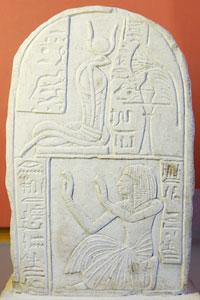

Meretseger (Mertseger, Merseger, Mereseger) was the goddess of the necropolis at Thebes (Waset, in the 4th Nome of Upper Egypt). Her name means “She Who Loves Silence”.
She was believed to live on the mountain which dominates the skyline at Thebes and rises above the valley of the Kings and Queens. The mountain (known as “dehent”) formed a natural pyramid, and the word for “pyramid” in Egyptian was “mr” which formed a pun on the first syllable of her name.
Meretseger was given the epithet “She who is on her mountain” and was sometimes thought of as the personification of the mountain itself, and known as “Dehenet Imentet” (“Peak of the West”). She was often associated with Ptah, the patron of the workmen at Deir el Medina.

She was a protective deity, but was also greatly feared. The workmen of the necropolis left numerous stelae dedicated to her. They believed Meretseger would strike down anyone who desecrated a tomb, as well as anyone who committed a crime or broke an oath. It was thought that she could cause immediate blindness or inflict a snake or scorpion bite on the guilty party. However, she was merciful and would cure anyone who repented and promised to atone for their actions. For example, a worker named Neferabu recorded that he had been punished by Meretseger for his sins. However, he confessed and did his best to make amends and the goddess forgave him and cured him of his affliction.
These notions of “sin” and “repentance” were not common in Ancient Egypt. They believed in Ma’at (balance or order) and chaos rather than “good” and “evil” and no other deity rewarded atonement and punished sin in this manner.
Her worship was popular in Thebes and Deir el Medina (the workman’s village near the Valley of the Kings) during the New Kingdom and a small temple to Ptah and Meretseger was built near by. However, she was so closely associated with the necropolis at Thebes that her worship was never established elsewhere. When the royal necropolis was abandoned during the Twenty-First Dynasty she drifted into obscurity.
Meretseger was usually depicted as a cobra or a cobra with the head of a woman, although sometimes she takes the form of a snake with three heads (a woman, a cobra, and a vulture). She occasionally appears as a woman or a woman with the head of a cobra, although this is fairly rare.
Bibliography
- The Complete Gods and Goddesses of Ancient Egypt (2003) Richard H. Wilkinson
- The great goddesses of Egypt (1999) Barbara S. Lesko
- Gods of Ancient Egypt (1996) Barbara Watterson
Copyright J Hill 2010